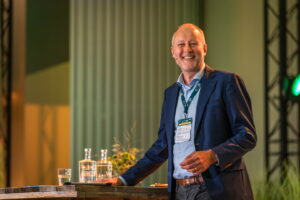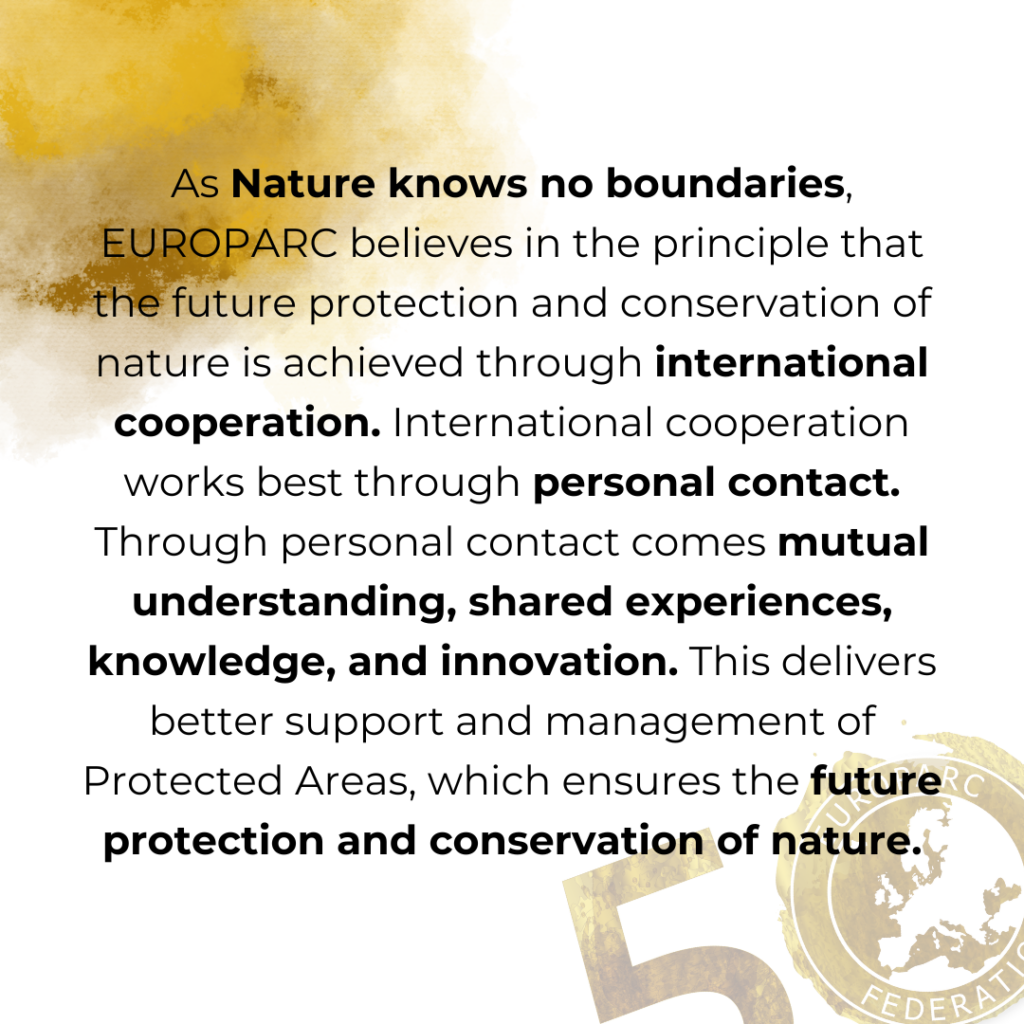#EUROPARC2023 – Conference Statement: The time to act is now!
During the EUROPARC Conference 2023, a special Conference Statement was produced. The statement underlines that to properly deal with the crisis we are currently facing, we need to listen to nature and create links with the wider society.
Creation of the statement EUROPARC Conference 2023
The EUROPARC Network is ready to create a future in harmony with nature. This message was echoed loud and clear after our annual Conference, taking place from 3 – 6 October in Leeuwarden, The Netherlands. Over 450 nature professionals gathered to dive into the theme of the week: Tribute to our Landscape – Where nature and people meet in Harmony.
To ensure a lasting impact, as well as to underline the united voice of the EUROPARC Network, a Conference Statement was created.
Jan van de Venis, picture by PDF-Grafie
This work was spearheaded by Jan van de Venis, president of the National Park Dunes of Texel, and part of the EC2023 organisational team, as well as EUROPARC’s Executive Director Carol Ritchie.
Through seven ‘steps’, the statement serves both as an inspiration, as well as a practical guide on how Europe’s Protected Areas can lead the way to a greener, healthier and harmonised future.
The statement was created for and by Conference participants. During an interactive session on Friday afternoon, participants were asked to come up with actions that can bring the Conference Statement to life. Some of these planned activities include:
- Promote volunteering opportunities to connect people to nature;
- Connect sporting groups with nature;
- Share personal ‘magical nature moments’ with others;
- Creating peer-to-peer learning spaces for all ages;
- Be the change you want to see.
We invite our members and the wider EUROPARC network to take the Conference statement further and turn it into reality!
Read the Statement now:
“Our conference theme is “Tribute to our landscape, where nature and people meet in harmony”. Celebrating 50 years of the EUROPARC Federation in 2023, the Leeuwarden Conference is a highlight. We invite participants to learn from our past and prepare for the future. We see nature’s decline, biodiversity loss, climate change, food concerns, and other worries about our planet. The conference makes a clear statement of intent and action to bring harmony between nature and people.
1. Past – Present – Future
Understanding our past and present helps us to work towards the future: the future we need and want. The connection between nature and culture manifests in diverse landscapes that change over time, whilst respecting our natural heritage and all life. Preserving landscapes’ core values for the future reconfirms and conserves our link to previous generations.
2. Harmony with Nature
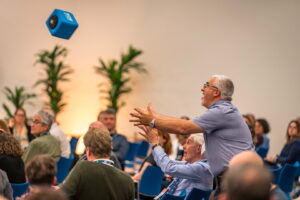
Participants could provide feedback during an interactive session. Picture: PDF-Grafie
Living in harmony with nature, a stable climate and no pollution, requires a change in human attitudes and actions. We recognise the impact of humans on the landscape and nature and current dis-harmony that exists between people and non-human nature in many places in Europe. Many people and cultures have forgotten or lost their place within global ecosystems. Climate and biodiversity cannot wait any longer: we stress that nature is the foundation of our existence.
3. Contact and interconnectedness with nature
Go out there and spend time in nature. We have different experiences and backgrounds. However, appreciating nature and all its diversity is crucial to recognise its value to human society. Storytelling can inspire a growing understanding of nature’s importance for our health, food, water and air. Share beautiful and connecting stories.
4. Knowledge
Even if humans know about nature, they tend not to act accordingly. Scientific knowledge and practical experience often stay in closed circles, instead of reaching out to people, beyond a “green bubble”. There is a need to reach consumers, business owners or other stakeholders. Behaviour change is necessary.
5. Be Amazed, Protect and Educate
Continue to marvel at nature and landscape beauty. Protected Areas have an essential educational role in reconnecting society with nature. You want to protect what you know and love. We need comprehensive approaches and cooperation to foster continuous environmental protection and nature education at European, national and regional levels. We need to work with the education sector to learn together – to share more between those knowledgeable in nature, heritage interpretation, environment and other areas.
6. Everywhere and all of the time
Nature exists everywhere: in natural areas, cultural landscapes, cities and towns – they are all connected. We should seek better links between such areas, by collaborating with managers, users, residents and other organisations. New technology can help, but it should be supportive rather than controlling.
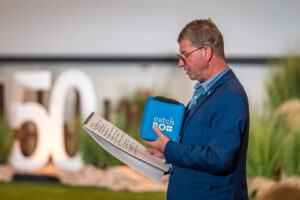
Participants could provide feedback during an interactive session. Picture: PDF-Grafie
7. Start and act now
We know that our landscapes face many challenges: overexploitation, intensification of uses, pollution, biodiversity loss, effects of climate change and loss of cultural heritage. Protected landscapes need to be pilot areas for integrated solutions. Let’s take the action needed now to move from fear towards hope. Creating a better, more natural world together must begin now. Not only should we focus on our current perspectives, we need intergenerational interaction where young and old learn together, share achievements and improvements, for a common future. A roadmap for change is needed, with everyone playing a role, individually and collaboratively.
50 years of EUROPARC have passed.
May the next 50 years of EUROPARC bring us towards a more mature relationship in harmony with nature. For present and future generations. For all life.”
We thank all that have contributed to the creation of this statement.
European Nature Academy: Face-to-face Workshops for Natura 2000 Marine and Forest Managers
European Nature Academy is an innovative co-learning platform offering cost-free training courses focusing on the competencies required to manage Natura 2000 and Protected Areas more effectively.
Courses focus on core competencies, including stakeholder engagement, communication tools and techniques and management planning. Specific attention is also given to the management of forest and marine ecosystems.
In LIFE ENABLE, Forest and Marine participants are organised in ‘PODs’ – these are small groups created to enable closer joint-working and co-learning between peers.
As part of the ENA programme, participants engaged in interactive courses that were comprised of multiple modules. These courses offered a variety of materials, including live online sessions, videos, e-books, and reading resources, which enabled participants to gain a broader understanding of the training topics. The courses also included interactive activities and assignments that encouraged participants to apply their newly acquired knowledge, as well as their existing skills and experiences. As a culmination of the online courses, face-to-face workshops were organised for Marine Participants in France and for Forest Participants in Austria. These workshops provided an opportunity for participants to put their knowledge into practice and interact with peers and experts in their respective fields.
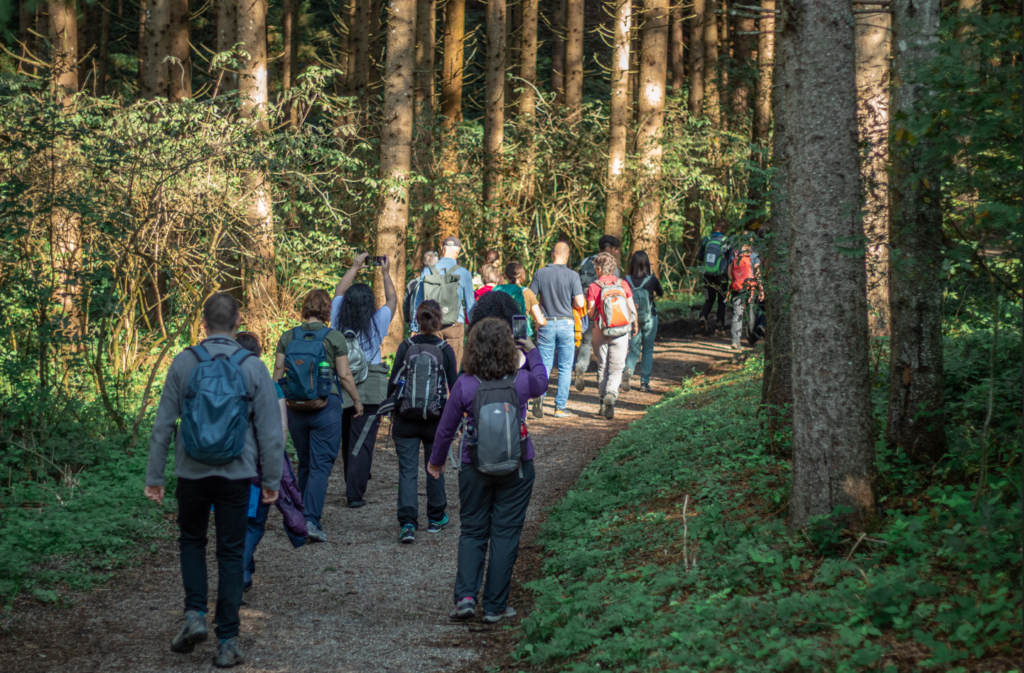
Forest Workshop took place in Austria
Tools for Natura 2000 Forest Managers
Online courses
The Tools for Natura 2000 Forest Managers course offered insights into:
- Forest conservation and management in Natura 2000
- Forest ecology
- Integrated Natura 2000 Site Management
- Monitoring and assessment
Face-to-face Forest Workshop in Austria
This 4 days workshop was hosted by E.C.O., with support from TESAF and FUNGOBE. A total of 27 participants from Norway, Germany, Cyprus, Spain, Croatia, Lithuania, Austria, Finland, Romania, Germany, Italy, UK, Belgium, Portugal, Latvia, Greece, and Slovenia visited multiple Protected Areas to engage in a range of field-based discussions about management practices being applied.
The workshop included visits to Nature Park Dobratch and Natura 2000 site Leonstein. Robert Heuberger. The Department of the Carinthian Government for Environment, Nature Conservation and Coordination of Climate Protection welcomed participants, followed by Stefano Santi, representing EUROPARC. The topic of the morning visit was climate resilient forests, where the host presented the forestry measures in the Nature Park to create more resilient forest stands. In the afternoon, participants visited the Natura 2000 site Leonstein, to discuss visitors and carrying capacity. The Protected Area is located in an area with considerable tourism: pressure from tourists, leisure tourists and recreationists is massive in the summer months. The area has a very dense network of hiking trails. At the end of the visit to a beech forest stand, a short POD task was organised where participants reflected on the positive and negative points of forest management at the two sites.
On the following day of the forest workshop, the group travelled to the Vellacher Kotschna (AT) in South Carinthia, a Natura 2000 site. The group held a discussion about the challenges of establishing monitoring indicators and explored management practices in privately owned forests within Natura 2000 sites. Later in the afternoon, the group crossed the border into Slovenia and was accompanied by hosts from the Nature Conservation Institute (Davor Krepfl and Sonja Rozman) to an old-growth forest situated in the Kamnisko-Savinjske Alps. The group had an informative session with the hosts, where they discussed the differences and similarities in Natura 2000 management across borders. At the end of the day, Erika Vaida Bela from ProPark organised an exercise that allowed the group to reflect on the day’s topics.
During the visit, the group explored the European Nature Reserve Lendspitz Maiernigg. It represents the last remaining 500 metres of the lake’s natural shoreline with reed belt and adjacent wetlands in an urban setting. The focus of the visit was on invasive species, and Susanne Glatz Jorde from E.C.O. led the group through the area with several stops along the way. An activity was organised where each POD had to identify the invasive species they found in the field. During the lunch break at the Lendkanal on the shore of Lake Woerthersee, Ms. Sara Schaar, the representative of the federal government, spoke to the participants and offered future cooperation in the development of conservation projects.
Later in the afternoon, the group gathered to receive an overview of the guidelines for the final assignment from Mike Huber from E.C.O. They then selected their topics, developed structures for the final paper, and sought feedback from the scholars on their topics.
Following the long day of work, the group concluded the official part of the Forest face-to-face meeting. They were greeted by the vice-Mayor of Klagenfurt, and Hanns Kirchmeir from ECO supported the straightening of Natura 2000 managers network through the LIFE ENABLE project.
The last optional excursion day near Lake Ossiach included a hike through a beautiful beech forest to the Finsterbach waterfalls. The group also enjoyed a breathtaking view of the Ossichersee from the Gerlitzen before driving to the Bleistaeter Marshes, which were previously intensively used as farmland. In 2002, it was designated as a Natura 2000 site after restoration measures were taken. Since 2017, the landscape in the Bleistaeter Wetland area has changed dramatically. Extensive shallow water areas and wetlands have been created on land that was once used for agriculture, with the aim of improving the water quality of Lake Ossiach. This creates an attractive habitat for rare animal and plant species and a unique recreational area.
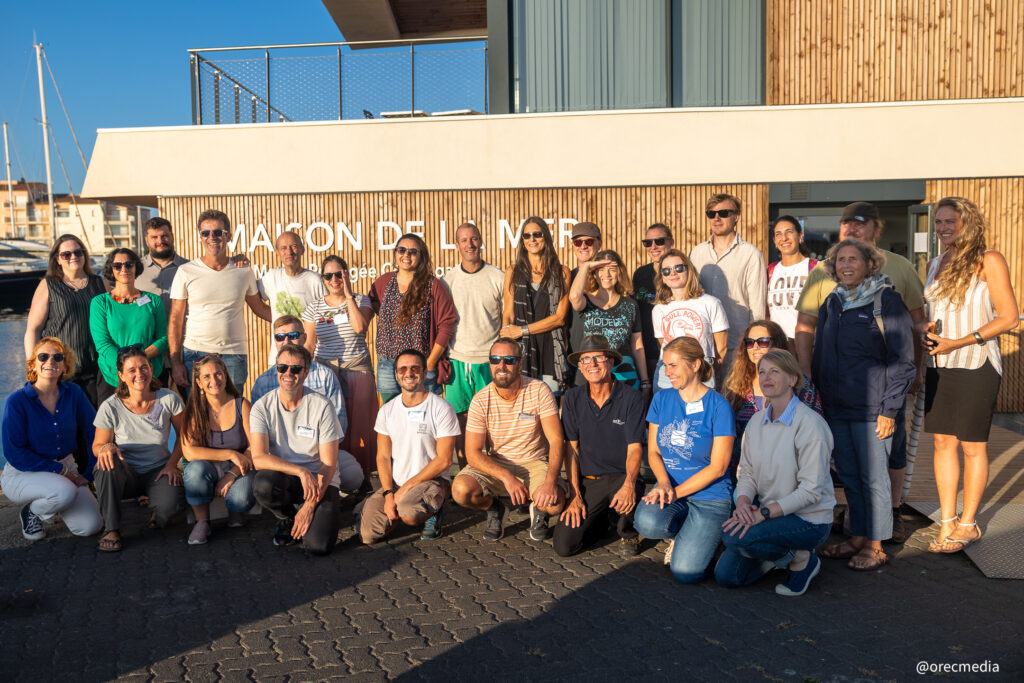
Marine Workshop took place in France
Tools for Natura 2000 Marine Managers
Through its modules, the Tools for Natura 2000 Marine Managers course highlighted the following topics:
- Policy and governance frameworks for Marine Protected Areas and Natura 2000 Marine Sites
- Marine Protected Area Management Planning
- Compliance and enforcement
- Management Effectiveness
Face to face Marine Workshop in France
The Marine face-to-face Workshop gathered 21 participants from Greece, Lithuania, Malta, Sweden, Scotland, Finland, Italy, Croatia, Spain, Cyprus, and Albania in Agde, France.
The focus of the first day of the workshop was to learn about the different ingredients of an effective MPA network, including selecting sites that work together operationally and understanding the added value that a network can bring to the managers of the MPA.
Through practical exercises, the participants worked on identifying, developing and putting together the main components for their own (fictional) successful MPA network.
The second day of the workshop was dedicated to constructing an effective management plan for MPAs. The participants started by defining the legal framework for an MPA and then worked on identifying target resources, assessing and analysing threats, and developing SMART objectives through practical exercises that helped visualise and make tangible the creation of these plans.
Building on the outcomes of the previous session on the design of an effective MPA Management Plan, the team of the MPA of Côte Agathoise presented their management plan. This covered how their actions have progressed over time and as their operational structures shifted from working as an association to becoming part of the municipality and operating in collaboration as of this governmental branch.
The second part of the second day was dedicated to designing and developing a management strategy that can impact different types of human behaviour that are harmful to the MPA’s target resources. The participants also worked on establishing monitoring and evaluation plans to track the effectiveness of their management strategy.
The day ended with a meeting with different stakeholders who are active within the Côte Agathoise MPA premises. Hosted in La Maison de la Mer, they presented their contribution to biodiversity conservation in the Protected Area and responded to questions from the participants.
During the last day of the Marine workshop, participants learned how to link strategy to law enforcement in MPAs. They learned how to recognise violations, track them, and stop them. The participants worked on identifying threats and the different actions they can take to help prevent illegal activities against the protected species and in no-take zones. They discussed the intricacies of preventing law breaches when it comes to recreational fisheries, as well as other illegal activities they usually encounter in their MPA.
To give participants an idea of how they can utilise law enforcement agents to protect their MPAs, the MPA of Côte Agathoise invited two officers from the rural police task force. The officers gave an overview of their mission within the MPAs and the different methods they use in case of illegal activities spotted in the zone. These methods include gentle reminders, verbal warnings, fines, and arrests. They also explained the training they had to go through to qualify for such missions.
Applying the skills on the ground
During both workshops, ENA participants had unique opportunities to experience various Marine and Forest ecosystems. They engaged in active discussions with experts and collaborated with their peers on interactive assignments, all while visiting breathtakingly beautiful Protected Areas in Austria and France. To get a glimpse of their productive workshops and experience the atmosphere, you can browse through the photo album capturing the highlights of their learning journeys.
ENA second round of applications
Did you find these insights interesting? Would you also like to enhance your skills, whilst networking with nature professionals from all over Europe?
If the answer is yes, you are in luck! European Nature Academy is currently still accepting applications for the 2nd intake of participants. You have a chance to apply until November 4th! Learn more and apply here!
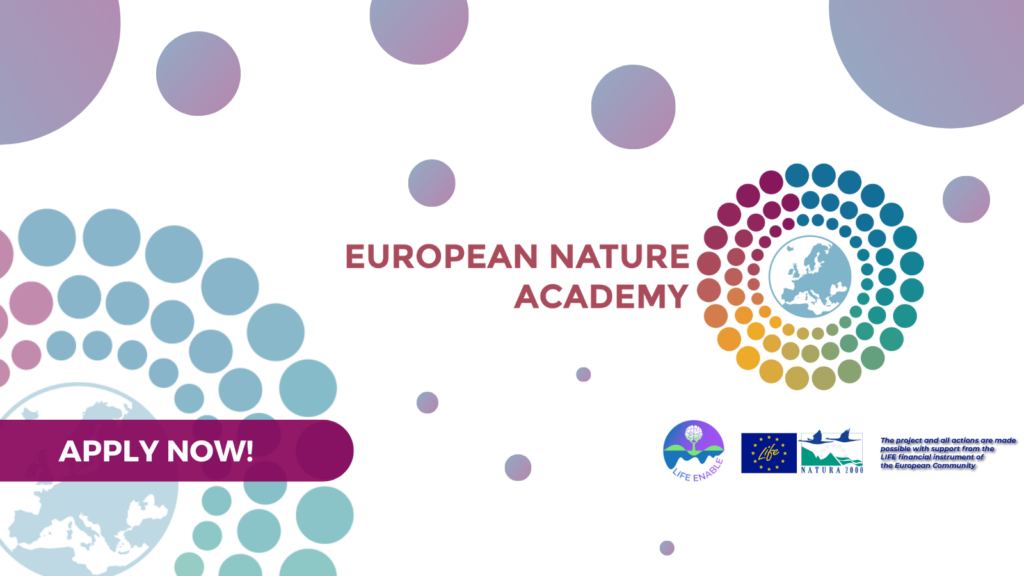
Hydrology and Grazing practices in 3 different Protected Areas
Espen during his study visit.
Espen Quinto-Ashman is one of the Alfred Toepfer Natural Heritage Scholarship winners of 2022. For his field trips, he visited three Protected Areas in Eastern Europe to learn more about their management practises, focussed specifically on hydrology and grazing management. This article, written by Espen, details his trips. You can also find a summarising video as well as his full report.
Article written by Espen Quinto-Ashman.
Aspirations of the study visit
Wildlife populations have declined globally an average of 69% between 1970 and 2018. A vast amount of irreparable damage has already been done, and it is likely to get significantly worse at an accelerating pace, even with immediate action. A radical transition away from a growth/consumption based societal system is urgently needed.
If managed correctly, Protected Areas are a vital resource in this struggle, preserving areas of particularly high importance to nature. Nature conservation in non-protected areas should equally not be overlooked, as protected areas cover far too small an area to maintain resilient populations alone.
My aspiration for this study was to learn from the management practices in different Protected Areas and consider how they could be utilized to maximize their effectiveness in protecting nature.
Watch a summary of his visits:
The Protected Areas visited
I selected my three protected areas to represent broadly different habitat types (even if the habitat varies within the area):
Extensive freshwater marshes (Biebrza National Park, Poland), ancient, unmanaged forest (Białowieża National Park, Poland) and meadows (Maramureș Natural Park, Romania). These are all habitats which have been significantly impacted by changes in land use over the past centuries, and their extent in Europe is now probably lower than at any other point in history. This means that Protected Areas are of vital importance to these habitats and the life they support. The management practices required to protect and maintain these different habitat types vary drastically, and this is often reflected in the management practices adopted within Protected Areas.
My study trips allowed me to get a ‘behind the scenes’ view on areas that I have long dreamt of visiting due to their high biodiversity and gave me an insight into the management realities in these areas. The trips were absolutely not all-encompassing, these are large areas with complex conservation issues and the specifics of their management require expert knowledge of the local conditions and history. However, there are several issues which are almost universal in the conservation of terrestrial (and sometimes aquatic) ecosystems.
Key issues
These issues require tailor made conservation strategies, sometimes active and sometimes passive, which are flexible to changing climatic conditions. It is also essential that conservation measures are not restricted to protected areas but also extended to the wider environment. These key issues can be summarised as follows:
- Hydrological systems in a poor state (due to, among other factors: land drainage, changing climatic conditions, pollution and changes to vegetation cover) are a factor in the declines of many species and the degradation of ecosystems as a whole, as well as that of agricultural land. Some of the challenges in the restoration of these systems are practical or financial (especially when it comes to large-scale projects), however the largest challenges are usually posed by opposition by stakeholders and bureaucratic hoops. These activities are essential and should be prioritised.
- Agriculture has and continues to change drastically, from small-scale and extensive, to intensive systems. This transition has an impact on biodiversity which cannot cope with the methods used, including the inputs of agrochemicals. These methods are essential for the growth and profitability of modern crop and livestock varieties but work against, rather than with natural systems. This is not sustainable and will lead to biodiversity collapse and large-scale crop failure. Another issue with changing agricultural practices is the abandonment of agricultural land, this leads to the succession and loss of valuable ecosystems. The solution to these issues can be found in traditional agricultural practices, using traditional varieties of crops and livestock suited to their specific environment with produce distributed locally.
- Forest ecosystems suffer from conventional forestry practices, which as well as destroying old growth forest, often do not allow for the natural development of forest ecosystems with long continuity in tree age as well as natural amounts of dead wood. Plantation of new forests after clear-felling leads to tree monocultures with extremely low biodiversity and a higher susceptibility to climatic events and disease outbreaks. Large quantities of timber and forestry ‘waste’ are used in the production of biofuels, this is not a sustainable replacement for fossil-fuels and is a key driver of demand for forestry products in many countries. The solution to these issues is to plan forestry practices around natural ecosystems and to increase the re-use of forestry products.
Natural ecosystems have never been more fragile and fragmented and the necessity for more careful agriculture, forestry and a reduction in development and extractive industries has never been greater. The consequences of continued ‘business as usual’ are dire, not only for nature but for us too.
The Alfred Toepfer Natural Heritage Scholarships are made possible thanks to the generous support of the Alfred Toepfer Stiftung.
Discover EUROPARC’s history through the voices of its members
In 2023, EUROPARC celebrates its 50th anniversary. To commemorate this milestone, a EUROPARC digital, interactive storybook was launched during our annual Conference in The Netherlands.
50 years connecting People & Parks
With great pride, the EUROPARC Federation presents EUROPARC’s history – as told by its members – through a digital, interactive storybook.
The heart beat of EUROPARC is its members, and the Federation its voice. Let’s share the story of EUROPARC through their own words.
To celebrate our golden jubilee, EUROPARC collected many stories from our membership over the past few months. Through interviews, video messages and old publications, we were able to pull together the stories of the people and events that have made our 50th Anniversary possible.
The content of the interactive storybook follows the essence on which EUROPARC was founded:
The storybook includes videos, pictures, spoken words and texts. We invite our members and the wider network to take a dive into the history of the Federation, through the stories of those that have lived it.
The EUROPARC Federation wants to thank everyone that submitted messages, took part in interviews, or shared their pictures of the past five decades. Furthermore, we want to thank our members, for their unwavering support and dedication to our Network, as well as to the conservation of nature in Europe.
We wish happy readings.

The publication of this digital, interactive storybook was made possible, thanks to the generous support of the Alfred Toepfer Stiftung.
